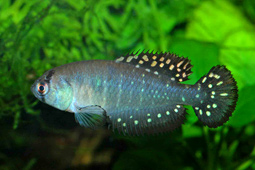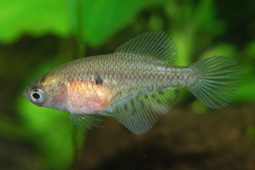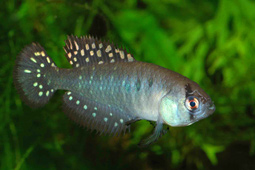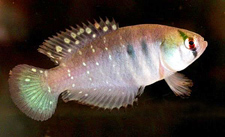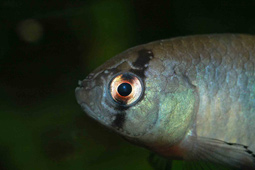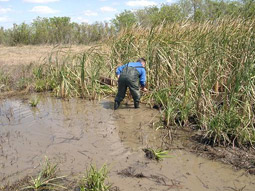The species was discovered by Dan and Patricia Fromm on June 11, 1993. The first location the species was found was along the road to Clorinda, President Hayes Dept., 500 mtr south of the Rio Negro, Paraguay.
The species name Austrolebias patriciae is chosen by J.H. Huber, France, to honor Patricia Fromm, the co- collector of the species together with her husband Dan Fromm.
In 2023, a work was published by F. Alonso et. al. in which he and his fellow ichthyologists chose to elevate the existing series of 7 subgenera within Austrolebias to the status of genus and to name 4 new genera. Thus, with this work, Austrolebias is now divided into 11 genera, i.e., Acantholebias, Acrolebias, Argolebias, Amatolebias (new gen.), Austrolebias, Garcialebias (new. gen), Gymnolebias, Cypholebias, Megalebias, Matilebias (new gen.), Titanolebias (new gen.)
Amatolebias patriciae new combination.
Amatolebias patriciae is small relative to the average of the genus, resembling Am. alexandri and affinis by its blue-green coloration, but distinguished when preserved by a rather less marked dichromatism, prominent anterior bars and by certain meristic data (males average A = 23-24 versus 21-23; LL=23-25 versus 25-26, and especially D/A = +2 to +4 versus -1 to -3); in addition, A. patriciae has a line of 8 - 12 neuromasts in place of a preopercular canal, and many others partially surround the eye, which is placed higher. The pectorals are long, reaching the fourth anal ray in the male (scarcely the first in alexandri and affinis) and the second in the female. Finally, a significant ( ?) element, the membrane between the rays of the vertical fins does not extend as far as their distal edge, the opposite of Am. affinis, thus creating a ragged outline.
Amatolebias patriciae is one of the 3 taxa that is placed in the genus Amatolebias together with A. varzaea and A. wichi.
Life colors :
Male, female, and juveniles dissimilar (the inverse of the color in alcohol). Only juveniles have large dark gray bars on the flanks and dark grey flames (= streaks) the length of the unpaired fins, more intense distally, almost forming a marginal band on the anal. The adult male is particularly handsome, especially when courting : the flanks are then an intense metallic green; normally only the lower flanks and the preopercular spot are bright emerald green, and the unpaired fins are densely spotted with the same color, all on an brownish beige base without stripes. A dark marginal band is present on the pectorals, the caudal, and the anal. The eye is, in contrast, circled with a brilliant orange and crossed by the black bar common among Austrolebias. The female is spotted vertically with maroon blotches on a lighter base, some, behind the opercle, are more intense and almost black. In color, the female bears a strong resemblance to the other small Austrolebias of Argentina, Uruguay, and the extreme south of Brazil.
Reproduction in general:
To breed most Austrolebias, you need a tank with about 10 to 25 liter water in it, a small jar or plastic container of about 10 to 15 cm high, a little bit of well-boiled peat moss, or coco-peat, and a water temperature between 18 and 24 C. It is wise to add a small filter to that tank and change the water regularly for 90 %. Bring one male and, if possible, two or more females in the tank and feed the fishes daily with live food like daphnia, red- and black mosquito larvae, and white worms. Austrolebias does not accept dry food quickly, and also, the prepared cow-heart is not preferred if live food is offered. If possible, breed this genus in larger tanks with more than one pair or trio and give some hiding places if you do so. When breeding with more than one male, you should also provide more than one spawning container. Every male must have one, and you will see they show interesting territorial behavior to attract females into their spawning place.
The male "flinders" around the female, displaying his fins high- up with the most intense colors. As the female is willing to spawn, she follows the male, pressing his head towards the layer of peat, and when the female contact the male's belly, both will dive into the peat layer. This layer should have a thickness of at least the length of the largest animal or, better, some deeper so they can dive entirely into it.
The spawning occurs during the whole fertile life of the fishes, starting at 5 to 6 weeks of age, till they become old and weak or die from the lack of water in their natural environment. This "end-of-life" will be within 8 to 11 months, depending on the temperature. Higher temperatures will trigger more rapid aging.
In the wild, Austrolebias live in colder environments during the wintertime. Temperatures in Uruguay, Paraguay, and Argentina can get very low. Incubation time usually is six weeks if stored at high temperatures ( 25 C.) and more extended if kept at lower temperatures. The development can last five to six months also. So it is wise to check the eggs regularly to see if the eyes inside the eggs are fully developed and the iris is well visible. When "eyed-up," put a part of the peat with the eggs in water at cool (ca. 18 C) temperature. If the fry usually hatches- and swims within a few hours, wet the rest of the peat. After hatching, feed the fry immediately with freshly born Artemia nauplii. A day or so later, I pour the water together with the fry off and place them in a well-filtered tank without any peat moss to grow up. Austrolebias are not used to strong currents, and juveniles can die if turbulence is too strong. The remaining peat will still have eggs inside that are not ready to hatch yet. Re-pack the peat and store it for some extra time. This hatching delay is nature's answer to short rain showers that fill pools only temporarily, followed by another dry period. Such an event would kill the entire population of the species in that area if all eggs were hatched with first rains. These (late) eggs will hatch later, sometimes very much later, and the fishes that were born earlier will eat these youngs.
As stated before, young's are growing fast and will produce their first eggs after 5 to 6 weeks already, if not even sooner. This breeding information applies to most Austrolebias. However, if the above Austrolebias- species have different behavior or extreme adult size, find these adaptions below in this chapter under <remarks>.
Remarks;
Variations
Map
Meristics
Dorsal 00.8,
Anal 00.0,
D/A 0.0,
LL scale count (average)00.0
Pre- dorsal length to % SL – 00.0 %
Depth to % SL – 00.0 %
Literature
Huber, J.H. 1995. Nouvelles Collections de Cyprinodontes paraguayens, avec Description de 4 Especes Rivulines inedites et Redecouverte dúne Espece a la Localite typique juscuálors indeterminee. Assoc. Killiphile Francophone de Belgique, Killi Contact, Aug. 23 (2): 6, fig. 2.
Alonso F., G.E. Terán, W.S. Serra Alanís, P. Calviño, M.M. Montes, I.D. Carcía, J.A. Barneche, A. Almirón, L. Ciotek, P. Giorgis, J. Casciotta, 2023. From the mud to the tree: phylogeny of Austrolebias killifishes, new generic structure and description of a new species (Cyprinodontiformes: Rivulidae) Zool. Journ. of the Linnean Society, XX, 1-30, Fig. 15, Tab. 2
